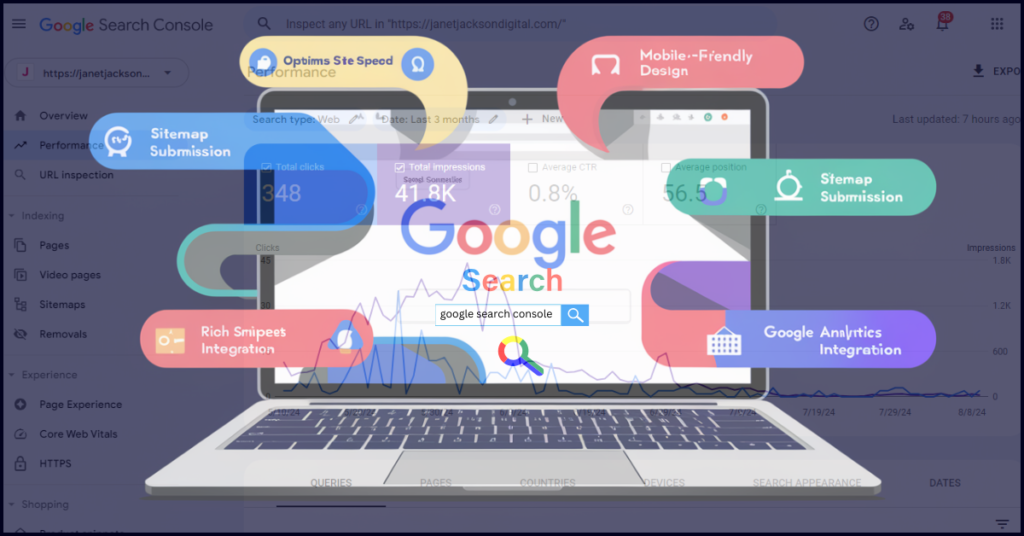Last Updated on August 11, 2024 by janetjacksondigital

Google Search Console Basics
For any webmaster serious about website performance, Google Search Console is indispensable. It is free to use, regardless of if you are a long-time SEO pro or this browser-based tool will provide some useful level insight on how your site interacts with Google Search. It is great to supervise your presence in Google’s search results, and it provides you the tools for optimization.
However, it has a lot to offer and working your way around its features can be intimidating at the beginning. How might the power of this money be utilized? Finally, I spoke about how to use a few tricks by which you can increase the visibility of your website. Today in our guide, we’ve got five golden strategies to help you succeed with Google Search Console.
Interface and Feature Overview
Initially, it might be difficult to navigate through the Google Search Console. It may be a bit complicated at first, but once you understand its areas of use and elements it is simply indispensable for your website.
The dashboard makes it very easy to see how you are doing. Remember that important data include average position, total clicks, and impressions. This helps to develop a quick overview of the way your website is doing in the search outcomes.
The left-hand sidebar provides access to other sections, allowing deeper diving. The “Performance” tab will also tell you which queries cause your site to appear in the search engine. Meanwhile, the ‘Coverage’ section shows you of any problems that might be affecting how well-pages are being indexed.
Knowing atleast these features will help you to take some decision regarding SEO practices and improvement required for more visibility in search. Every bit of these components collectively helps users to have the best experience possible and also enables better performance online.
Should you be using Google Search Console for your site?
The Google Search Console is basically a must-have for any website owner. This tool is your gold mine which provides you with a plethora of data on the ranking status of your web page in search advice. When you understand this interpretation of data it only helps in making intelligent decisions.
Google Search Console: Having this tool means you can keep her on for when she needs some help with your site. Helps You Find Issues Holding Back Performance– These might include issues such as broken links or crawling errors. These fixes, can both improve user experience and increase your rankings.
Additionally, the platform presents keyword performance metrics. The secret to a good content strategy is figuring out what searches generate the most traffic. Thus, it helps you get effective user targeting.
One of the key benefits is the ability to track the indexing status. This helps to raise awareness and connect with those who are searching for a specific topic online.
In a world with internet of things and some very serious digital competition, you need to use all the new tools available in order to stand out amongs crowds who may just forget what Google Search Console has already made simple. Using this tool helps you to boost your SEO efforts significantly.
How to Use Google Search Console (for Beginners 2024)
5 Essential Tips for Using Google Search Console to Boost Your Business
There are suggestions that help you set up Google Search Console to be better for optimization of the site. Here are five critical hacks to enhance your performance.
Step 1 — Custom Domain This is going increase the visibility of brand and make search engine to identify your site more efficiently.
Then open the performance report. It outlines how your content is discovered, which keywords bring traffic. We’ll be using this data to refine our SEO strategy.
You need a working webmaster tool and you have to check the index status too. Make regular checks for mistakes that can harm your rankings in search results and if you see them just fix it.
Secondly, do not forget to check the mobile usability as well. Since there is mobile-first indexing, it’s crucial that your site performs well on the go.
Regularly send the sitemaps to Google as well. This results in more effective crawling, with all pages getting indexed quickly and seamlessly accessible to users online.
A. Setting Up a Custom Domain
You need to setup your custom domain here, for you brand reputation over the online world. If, in the resolution of your issues, you are able to reach this point then you should verify ownership of that domain first. Some ways to prove ownership include either adding a TXT record in your DNS settings or uploading an HTML file onto your website.
Check, you receive some useful information such as how Google fetches and index your site. Own Your Brand: In URL, a custom domain builds user trust. If a website looks professional, people will feel good about interacting with it.
Some changes can take a while to be seen in Search Console Wait for the updates to an indexing status and performance metrics after the initial setup
Maximize the value of that critical tool in helping you make data-driven decisions for an effective digital strategy.
B. Using the Performance Report
This is the reason why Performance Report in Google Search Console Our Responsibility(Mine) Goldmine of data well, it contains details like Clicks, Impressions and Average position for different pages of your website. That data should give you an idea of how your content is performing, and that can be good information depending on what sort of things users are doing.
Get to the nitty gritty with detailed drilldown through search queries, countries or devices.
Track the Keywords Driving Traffic to Your Site Experiencing high-impression low-click positions? Well, that’s a chance to dull those titles and meta descriptions.
Monitoring of historical changes is again another feature that we never used so far. You can easily check the influence of recent updates or content changes with performance trends.
Annual performance comparisons don´t forget about it! Such viewpoint helps to find systemic seasonal patterns, and suggests a strategy for developing future systems within the first calendar year.
C. How to Check Index Status and Correct Errors
Visibility Monitoring a site’s indexing status is very important. Once more, Google Search Console has taken the guesswork out of which pages are indexed and those that have not. This will give you an idea of how well or badly your website performs in search results.
Errors can break your site. The “Coverage” report helps you find issues such as 404 errors or server problems stopping your pages from getting indexed correctly. Rapid correction of these errors is critical to enable users discover what they came searching for quickly.
Bonus Tip: Use The URL Inspection Tool too. You can quickly view the index status and any problems with a particular page in real-time.
By fixing these issues, you enhance user experience as well increase your site authority Google eyes. You cannot ignore the importance of keeping a tab on this, because doing so can really boost your organic traffic and thereby become an important tool in SEO strategy.
D. Optimize Mobile Usability
Ensuring mobile user friendliness is more crucial than ever today. This will also have a bottom line impact on traffic and design as this causes most of your visitors to more likely stick around.
This is where Google Search Console helps to improve it on mobile. Review the report on “Mobile Usability” to find out things like clickable elements are too close as well (content is not wide enough). These can be a source of frustration for your users, even causing some to leave.
Employ the principles of responsive design to enable seamless navigation across different devices. As a last prep, test the performance of your website using Googles Mobile-Friendly Test tool to confirm there are no unsolved challenges.
Remember, making your daily life the best that it can be on mobile has a direct impact of increasing user engagement and their sense of well-being. Not only are you sending the right kind of signal to Google, but also catering for modern behaviours around speed and user experience.
E: Submitting Sitemaps for Improving Crawling and Indexing
This is an important step to increase the visibility of your site on Google. A well organized sitemap functions as a map for search engines and helps them navigate through your content.
If you have not generated your sitemap, create one and then submit that on Google Search Console. With the assistance of many tools you will create an XML sitemap. When your sitemap is prepared, you can open Google Search Console and follow the “Sitemaps” tab in which type that URL for instance.
This one simple step will help you to prevent your site from getting all pages crawled and indexed by Google in the best way possible. It is particularly useful for large websites and sites with regularly changing content, where new pages may not be discovered quickly.
After the submission, we need to exhibitor status periodically that gives a feasibility of getting any error instantly. This will let you keep a monitor on the issues arising, if any while crawling or indexing.
Google Search Console Advantages
How well is my site performing on Google Search Console?: This provides you with performance insights into your website in search results such as clicks, impressions and ranking average position.
Indexing Information: Gives an idea of how many pages are indexed by Google and circulate any indexing issue, that could be one reason your site isn’t searched very well as it potentially can.
Search Traffic Analysis—Users can get a detailed look at search queries that bring people to their website so they gain more knowledge about the user intent and optimize content.
Mobile Usability Reports: Here is a tool that offers reports on mobile usability which helps in optimising your site for the mobile as per Google standards.
Issue Notifications — As an essential tool for monitoring the security of your site, GCS alerts webmasters about important types of issues and provides high-level information on how to fix any problems.
Google Search Console Disadvantages
Complex UI: New users may struggle to learn all of its functionalities in an optimal way.
Limitations in Data: The historical data is limited and the analysis of trends for a longer term may not be possible.
Few Direct Traffic Metrics: GSC lacks direct traffic metrics for pages; instead, it is centered around search results performance over holistic site traffic.
Delayed Updates: Changes in latency when looking at the data. potentially viewing old info as it relates to site changes and optimizations on your website.
Sparse Support Options: Documentation exists, but not as many direct support options compared to other paid tools exist, which can make it harder for certain users who need troubleshooting.
Conclusion
Google Search Console is packed to the rafters with invaluable tools and insights that can make a huge difference in how well your site performs. If you want to pave your way in internet marketing, then these features are not just user-friendly; they make it the primary tool.
Though some of the more common functionalities may be ignored, it is also crucial to follow them. Do not forget to check your Indexing click on Coverage and Crawl Errors. If any error found re-crawling errors can affect the visibility of your site, So always do a regular quincy indexation. Keep track of the performance report metrics so that you can monitor how effectively your pages are performing.
Also, consider mobile usability scores since an increase of your users are using smart phones to view content. So improving in this area can drive better engagement. By submitting sitemaps, you are making sure that all the relevant information regarding your site structure is available to search engines.
When properly used inside Google Search Console, these will help take your SEO results to the next level and make for a healthier website overall. Be empowered with the power of data available at your fingertips. You will see a complete 180-degree take on how you think about web management.
FAQs
Google Search Console Frequently asked questions (FAQs)
How To Verify Your Website With Google Search Console
Verify Your website, Add Meta Tag in your HTML file or Upload HTML File on Your Server OR Set Parameters from Domain Provider (The Easiest way to Verify) Or Via Google Analytics
What Data Can I Find on Google Search Console?
Users can view how their site works with Google’s search engine like data on how good a particular web page is, indexing status of multiple pages, any concerns around the mobile-friendly version or not and significant reports for security issues.
What Is The Update Frequency Of Google Search Console Data?
While this is updated daily for most data in Search Console, some reports may take a little longer to process and will be available in the new edition of Search Analytics (stay tuned).

My name is Janet Jackson Seo and I work as a SEO Expert. I appreciate the process of developing an innovative approach and employing logic, particularly when it concerns future studies and SEO optimization. As an SEO expert I have known how to set up SEO campaigns fully and how to monitor their achievements.





